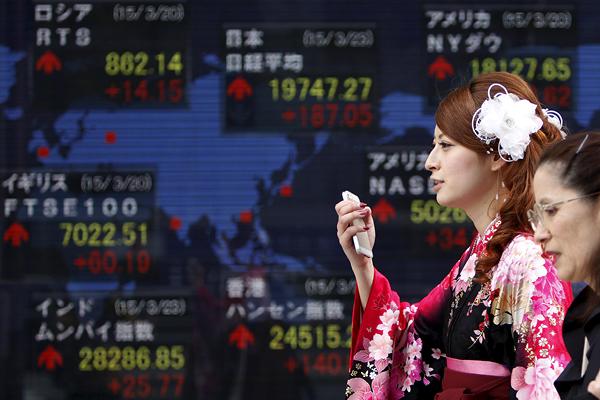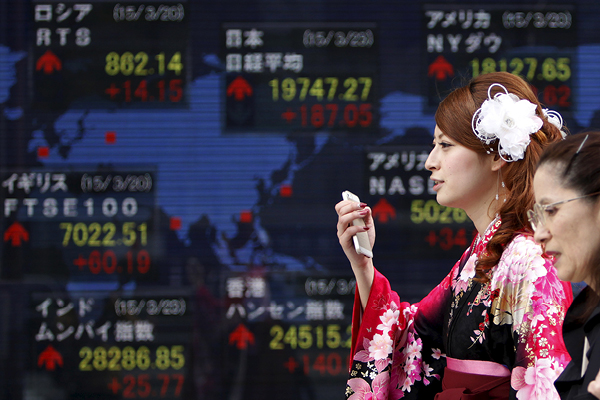
Japan Inc’s appetite for overseas acquisitions shows no sign of abating, even as the value of the yen against the U.S. dollar weakens. The need for Japanese companies to expand abroad greatly outweighs concerns over the unfavourable exchange rate, lawyers say. “There has been an almost 50 percent drop in the value of the yen in just a few years, yet that has not led to a noticeable drop in outbound activity,” says Takahiro Saito, a partner in Simpson Thacher & Bartlett’s Tokyo office. “The need to maintain growth is the key factor here. Japanese domestic consumer markets are declining, so in order to pursue growth they need to look abroad,” he says.
Back to top
THE OUTBOUND PUSH
According to the International Monetary Fund, Japan’s economy is forecast to grow by a mere 0.8 percent in 2015 and by 1.2 percent in 2016. Meanwhile, the value of the yen has nosedived from around 78 to the U.S. dollar in July 2012, to roughly 123 to the dollar in July 2015. However, outbound activity is skyrocketing. Thomson Reuters data show that Japanese outbound M&A volume for the first half of 2015 hit $49 billion, a whopping 43.6 percent increase compared to the $34.1 billion recorded during the first half of 2014. “The expansion abroad is structural rather than opportunistic. When the yen first started to decline, we were worried that it might affect Japanese outbound investment. But in actual fact that didn’t happen,” says Hideo Norikoshi, a partner at Baker & McKenzie in Tokyo.
The decline in M&A activity during the first half of 2013 was mostly due to the volatility of the exchange rate, rather than the actual exchange rate. This volatility affected the psyche of Japanese acquirers, because they simply did not know how much they would have to pay on closing, explains Norikoshi. “But with Japan’s currency now settled at the range of around 120 yen to the U.S. dollar, Japanese companies are comfortable with a stable exchange rate, and they continue to go outbound,” he says.
Half of the Japanese outbound deals in the first half of 2015 targeted Asia Pacificbased entities, according to Thomson Reuters. Southeast Asia’s emerging markets are particularly enticing to Japanese investors, as the region boasts healthy growth rates and burgeoning consumer markets. “We are seeing a lot of investment in Indonesia, Thailand and Vietnam, and we are hoping to see the same trend in Myanmar, where Baker & McKenzie opened an office last year,” says Norikoshi. “But by acquiring companies in Southeast Asia, Japanese acquirers may be inheriting unknown compliance and market risks. Compared to some Asian destinations, Europe and North America are seen to be relatively safer, although they tend to be relatively expensive,” he adds. For his part, Simpson Thacher’s Saito says that in addition to developing markets such as Southeast Asia, Japanese companies are also seeking further opportunities in North America. “We are continuing to see acquisitions in mature markets, particularly with respect to certain industries such as finance and insurance. Given the economic situation in a lot of mature markets these days, there appears to be plenty of opportunities for acquisitions,” he says.
U.S.-based targeted entities accounted for 36.1 percent, or $17.7 billion, of Japanese overseas acquisitions for the first half of 2015. The U.S. insurance sector in particular has seen an influx of Japanese investment. In June, Tokio Marine Holdings Inc agreed to buy HCC Insurance Holdings Inc for $7.5 billion, in what is the biggest M&A deal this year by a Japanese company. In February, Dai-ichi Life Insurance Co completed its $5.6 billion acquisition of Protective Life, a mid-sized life insurance firm. And in July, Meiji Yasuda Life Insurance Co announced its purchase of StanCorp Financial Group Inc for $5 billion. “Because of the nature of some industries, setting up new businesses from scratch is a bit of a hassle, whereas if you acquire licensed businesses in those countries it becomes a lot easier,” says Norikoshi, whose firm advised on the Meiji Yasuda and Dai-ichi Life deals.
Back to topAPPETITE FOR IPOs
With outbound M&A reaching new highs, Japan’s IPO market is also on the upswing. According to estimates from Nomura Holdings, as many as 100 Japanese companies are preparing to go public this year – up from 77 in 2014 – and are expected to raise in excess of 2 trillion yen ($17 billion). “The success of recent IPOs has been stimulating the appetite of investors. The initial market prices after a listing exceeded the offering prices in more than 70 percent of IPOs in the last five years,” says Ken Takahashi, a partner in Baker & McKenzie’s Tokyo office
In June, Japan Post Holdings Co filed to list itself and its two financial units on the Tokyo Stock Exchange, in what is set to be the biggest sale of state-owned enterprises in nearly three decades. The government aims to raise about 4 trillion yen ($30 billion) through several rounds of offerings of the mail and financial conglomerate. “The Japan Post deal is a behemoth and is going to be the story of the year,” says Saito. “The stock market is strong, and there is healthy IPO activity. This trend is carrying on from 2014, which saw major IPOs like Recruit Holdings, Skylark Co and Seibu Holdings,” says Saito, who advised the issuer on all three deals. The Seibu and Skylark offerings were styled as exits by private equity funds, and Saito expects to see more IPOs by private equity-backed firms going forward so long as the market remains strong.
Meanwhile, Line Corp, the operator of Japan’s most popular mobile-messaging service, is preparing for an IPO that could value the company at more than 1 trillion yen ($8.08 billion). Universal Studios Japan is also planning a mega listing this autumn, which could raise between 600 and 700 billion yen ($4.9 to $5.7 billion).
“In terms of the size of total funds raised, this is the most robust the Japanese market has been for 17 years, but this is due to some mega deals,” says Takahashi. “In terms of the number of IPOs, the Japanese market is still on its way to recovery. Before the subprime mortgage crisis, we had an average of 150 IPOs in 2005, 2006 and 2007. But after the crisis, the number of IPOs in Japan dramatically declined to 19 in 2009. Since then, the number of Japanese IPOs has been recovering gradually for five consecutive years, but has not yet reached the levels of 2005 to 2007,” he adds.
Back to topCORPORATE GOVERNANCE REFORMS
The Japanese government is also playing its part in enhancing corporate governance to help boost investor confidence. In February 2014, Japan’s Financial Services Agency (FSA) released the voluntary Stewardship Code, which aims to promote corporate growth through investment and dialogue. Japan also recently amended its company law and established the JPX-Nikkei 400, a stock index comprising companies with stronger governance, earnings and return on equity. And in June this year, Japan’s first-ever Corporate Governance Code came into effect. The reforms require firms to appoint at least two outside directors and introduce new rules to improve governance practices at listed companies.
Despite stiff corporate resistance, the reforms were pushed forward, partly due to demands from foreign and local investors to address Japan’s seemingly weak corporate governance regime. The infamous Olympus scandal in 2011 sent shockwaves through the global business community. And more recently, a report made in July by an outside panel of accountants and lawyers said that Toshiba Corp had overstated its operating profit by 151.8 billion yen ($1.22 billion) over a period of several years, roughly triple Toshiba’s initial estimate. Toshiba’s chief executive Hisao Tanaka has since resigned from his position at the company, along with a number of other senior executives. “Scandals like the recent troubles at Toshiba still occur, and that isn’t helping to boost foreign investors’ confidence in Japan,” says Saito. “The corporate governance changes that are going on are generally incremental in nature, and there are also cultural issues that will require some time to resolve. But policymakers realise that the strengthening of corporate governance is a key issue that needs to be resolved, and I believe things are going in the right direction from a long-term viewpoint,” he says.
While the new corporate governance code is certainly a positive step, what Japan lacks is proactiveness among institutional shareholders, suggests Norikoshi. “In the UK, for example, there are a number of very strong institutional shareholder associations. They are proactive and communicate very eloquently with the companies about what they like and don’t like. That is playing a big role in corporate governance, whereas in Japan the institutional shareholders are still quite silent, which is a bit disappointing,” says Norikoshi.
Nonetheless, the pipeline for outbound M&A and IPOs in Japan looks healthy, despite some uncertainty over the effects of a consumption tax hike next year, as well as the direction and success of “Abenomics”, Prime Minister Shinzo Abe’s three-pronged economic policy. Japanese companies are showing no signs of slowing down their spending to secure future growth abroad. And as the government’s corporate governance enhancements start to take root, business and investor sentiment in Japan is likely to improve. “There is that lingering worry in the back of everyone’s minds in Japan about where Abenomics is going to lead to, and if it is ultimately going to work,” says Saito. “We will see, but currently the optimists certainly outnumber the pessimists.”
Back to topMOVING INTO SOUTHEAST ASIA
As ALB reported last year, Japan’s local law firms are strategically following their clients overseas in Southeast Asia, stressing the importance of having a physical presence abroad to better service Japanese companies on their outbound acquisitions, and to assist regional companies looking to do business in Japan.
The table below provides a summary of the locations and launch dates of the ‘Big Five’ Japanese law firms’ overseas offices.
The most recent office openings (since ALB last published its Japan Report in September 2014) are highlighted in red.
| Anderson Mori & Tomotsune | Mori Hamada & Matsumoto | Nagashima Ohno & Tsunematsu | Nishimura & Asahi | TMI Associates |
Cambodia |
|
|
|
| ● Phnom Penh (July 2014) |
Indonesia | ● Jakarta Desk (in the office of Roosdiono & Partners) (May 2015) |
|
| ● Jakarta (in association with Rosetini & Partners (November 2014) |
|
Singapore | ● Singapore (November 2013) | ● Singapore (February 2012) | ● Singapore (January 2013) | ● Singapore (January 2012) | ● Singapore (October 2012) |
Thailand |
| ● Bangkok (April 2015) | ● Bangkok (April 2014) | ● Bangkok (July 2013) |
|
Vietnam | ● Ho Chi Minh City (May 2015) |
| ● Ho Chi Minh City (July 2014) ● Hanoi (April 2015) | ● Ho Chi Minh City (October 2010) ● Hanoi (September 2011) | ● Ho Chi Minh City (November 2011) ● Hanoi (September 2012) |
Myanmar |
| ● Yangon (April 2014) |
| ● Yangon (May 2013) | ● Yangon (October 2012) |
Other overseas offices | ● Beijing (1998) ● Shanghai (September 2013) | ● Beijing (1998) ● Shanghai (2005) | ● New York (September 2010) | ● Beijing (April 2010) ● Shanghai (February 2014) | ● Shanghai (1998) ● Beijing (December 2012) ● Silicon Valley (July 2014) |



